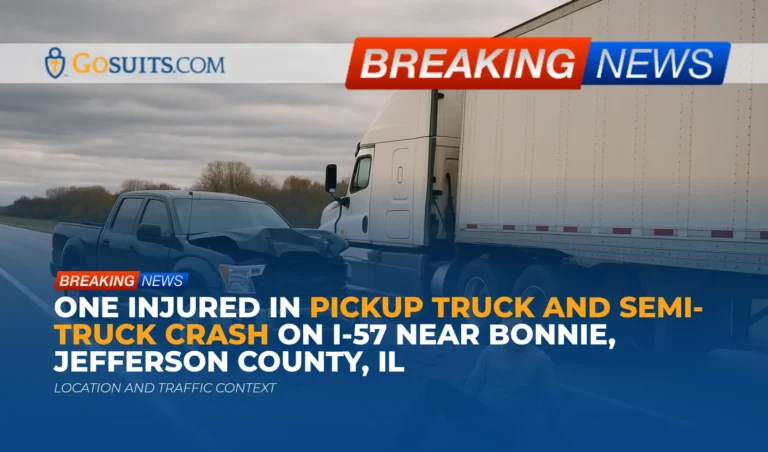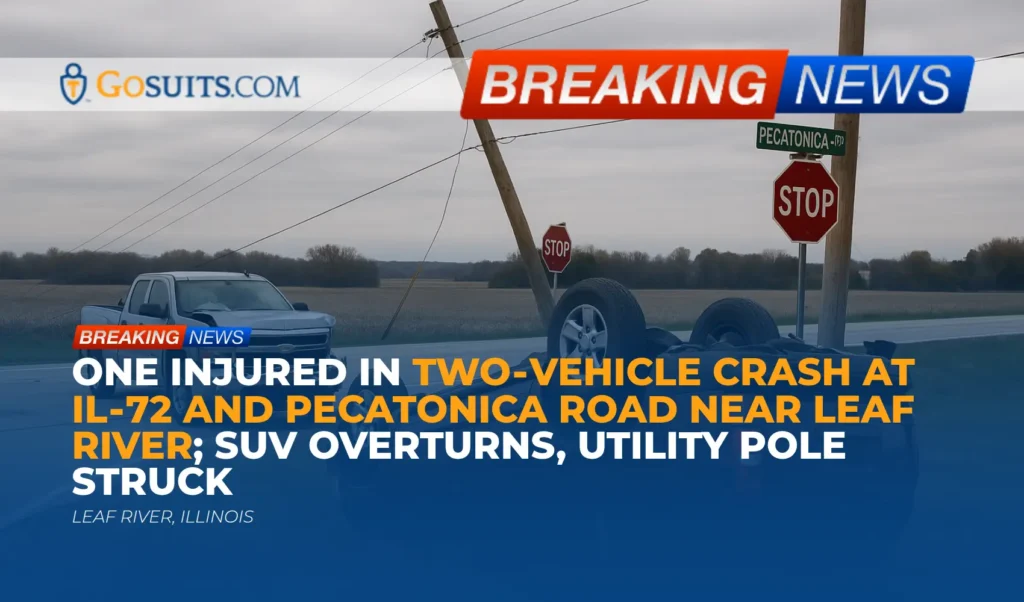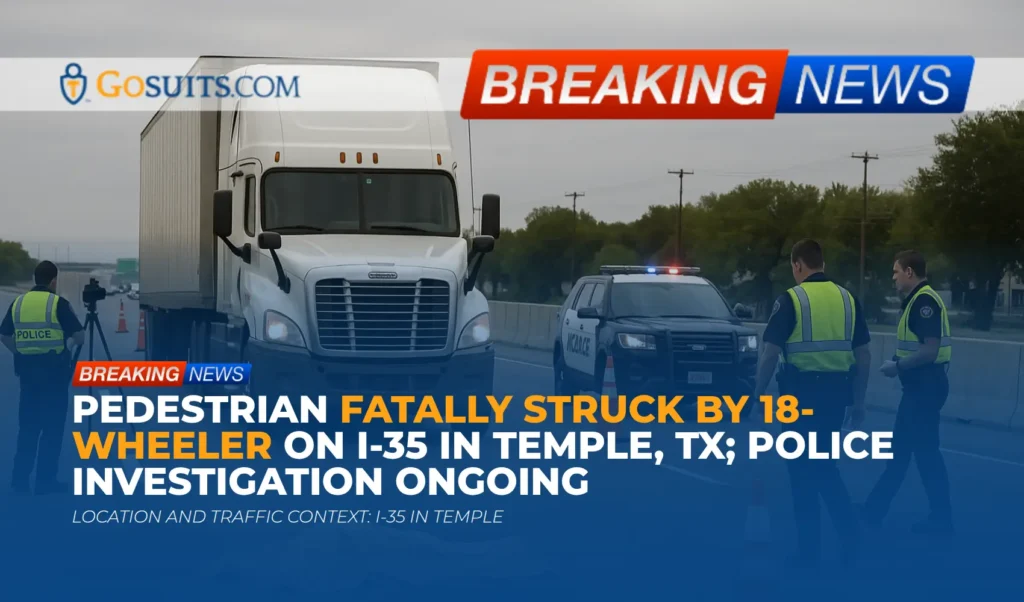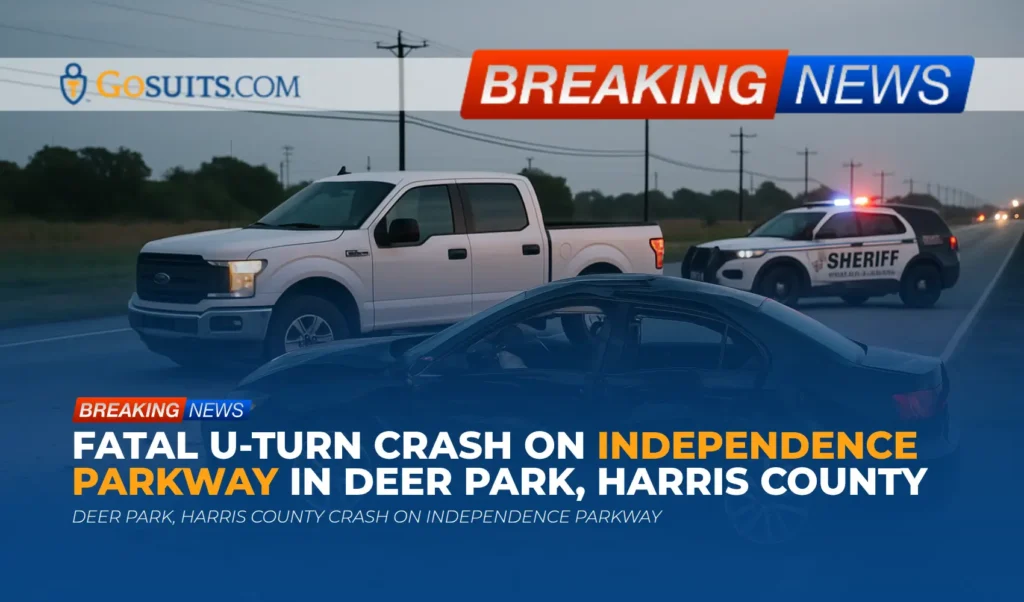- Incident overview
- Location and traffic context
- Official information and early findings
- Rear-end collisions with semi trucks: what to know
- Potential civil liability and insurance considerations in Illinois
- Evidence that often matters in a pickup–semi crash
- How to get key documents and information
- Medical care and recovery considerations
- Illinois laws that may affect a potential claim
- Road safety notes for the community
- What remains unknown at this time
- Commentary from Gosuits Bonnie, Illinois Personal Injury Attorney
- Why timely action matters: practical next steps
Incident overview
According to initial information provided by the Illinois State Police and reported by local media, a two-vehicle crash occurred on Interstate 57 northbound near milepost 85, just south of Bonnie in Jefferson County, Illinois. The collision happened around 12:45 p.m. on Tuesday, October 21, 2025. Early statements indicate that a pickup truck rear-ended a semi truck. One driver was reported injured. No additional details regarding the severity of injuries, contributing factors, or traffic closures were immediately available at the time of the report.
Rear-end collisions on interstates often involve issues such as speed, following distance, traffic slowdowns, visibility, or roadway conditions. When a passenger vehicle impacts the rear of a large commercial vehicle, the dynamics and injury risk can be significant due to the size and weight differences between the vehicles. This overview summarizes what is known and provides context on safety, potential legal implications, and important steps for obtaining records and support.
Location and traffic context
The crash location is Interstate 57 northbound near milepost 85, south of Bonnie, in Jefferson County. I-57 is a major north-south corridor carrying both passenger and commercial traffic. The area can experience variable speeds due to merging, passing, work zones, or congestion. Even brief slowdowns can create conditions where a momentary lapse in following distance results in a rear-end impact, especially when a heavier vehicle is involved.
Although traffic and weather conditions at the time were not specified, rural interstate segments can involve long-distance hauling by commercial trucks. Traffic flow changes, glare, distraction, or speed differentials between vehicles may all affect stopping distances. Larger trucks require longer distances to slow or stop, and vehicles following closely behind can be at risk if traffic suddenly changes ahead.
Official information and early findings
Authorities indicated that a pickup struck the rear of a semi truck. One driver was injured. At the time of this writing, there is no public confirmation regarding citations, specific causes, or the disposition of either vehicle. Official crash reports from the investigating agency are often the best source for technical details such as point of impact, roadway conditions, and witness statements.
Illinois State Police maintain a system for requesting crash reports. Members of the public and involved parties can seek reports through the Illinois State Police Crash Reports portal at isp.illinois.gov/CrashReports. Availability can take days to weeks depending on the investigation and report completion.
Rear-end collisions with semi trucks: what to know
Rear-end crashes are among the most common collision types on U.S. roads. Federal safety agencies caution that maintaining adequate following distance, staying attentive, and adjusting speed for traffic and environmental conditions are critical to preventing these events. The National Highway Traffic Safety Administration provides general safe driving guidance, including defensive driving and distance management, at nhtsa.gov/road-safety/defensive-driving.
Crashes involving heavy commercial vehicles present additional considerations. Federal Motor Carrier Safety Regulations require motor carriers and commercial drivers to follow safety rules designed to reduce crash risk. These include hours-of-service limits intended to address fatigue, and inspection and maintenance obligations to ensure braking and lighting systems are functioning as designed. For background, see federal guidance on hours of service at the Federal Motor Carrier Safety Administration’s site fmcsa.dot.gov and vehicle inspection and maintenance rules at the eCFR for 49 CFR Part 396 ecfr.gov.
Key safety dynamics in pickup–semi rear-end crashes include:
- Stopping distance mismatch: Even if a semi slows gradually, a following pickup may not have sufficient distance to react if the driver is inattentive, fatigued, or visibility is reduced.
- Underride risk: At higher speeds, a rear impact can involve a passenger vehicle traveling beneath the trailer. Federal standards require rear underride guards on many trailers, but their effectiveness depends on design, maintenance, and impact specifics.
- Visibility and lighting: At dawn, dusk, or in adverse weather, trailer conspicuity treatments and functioning lamps are important. Maintenance lapses or lighting failures can increase risk.
- Traffic flow changes: Congestion waves, work zones, and sudden braking can cascade into rear-end events when following distances shrink.
Potential civil liability and insurance considerations in Illinois
Determining civil liability in a rear-end crash involves a careful look at many factors. In general, following too closely and failing to reduce speed to avoid a collision may point to negligence by a following driver, but liability is not automatic. Investigators and, later, insurers or courts may consider whether the lead vehicle’s conduct contributed to the crash, such as abrupt lane changes, faulty lighting, sudden mechanical problems, or improper stopping in traffic.
When a commercial vehicle is involved, additional layers can be present. Potentially responsible parties can include the driver, the motor carrier employer, a trailer owner, a maintenance contractor, or a freight broker, depending on the facts. Commercial auto policies typically have higher liability limits, and federally regulated carriers must meet minimum financial responsibility requirements. Understanding all insurance coverages in play, including a pickup’s liability, medical payments, and uninsured or underinsured motorist coverages, is important.
It is common for insurance adjusters to reach out quickly after a collision to obtain statements. Statements given without a full understanding of rights and the facts can be used later to challenge liability or reduce compensation for losses. It is prudent to speak with a qualified attorney before giving any recorded statement to an insurer so that rights are protected and communications are carefully managed.
Evidence that often matters in a pickup–semi crash
Early preservation of evidence can make a significant difference in evaluating how and why a crash occurred. Items that often become important include:
- Police crash report and scene documentation: Diagram, narrative, roadway measurements, and any citations issued. The Illinois State Police crash report is the starting point for many claims.
- Photos and video: Vehicle damage, resting positions, skid or yaw marks, debris fields, lighting conditions, and any nearby cameras. Dashcam or nearby business footage can be crucial if obtained promptly.
- Event data and telematics: Passenger vehicles may have event data recorders that capture speed and braking inputs. Commercial vehicles can have electronic logging devices and engine control module data that reflect speed, throttle, braking, and duty status.
- Vehicle inspections: Post-crash inspections can reveal brake conditions, lighting function, conspicuity tape condition, and other maintenance items relevant under federal rules such as 49 CFR Part 396, accessible at ecfr.gov.
- Witness statements: Independent witnesses can clarify traffic flow and behavior of both vehicles before impact.
- Medical documentation: EMS run sheets, emergency department records, diagnostic imaging, and physician notes help establish the nature and extent of injury.
How to get key documents and information
Several government and health agencies can provide records that help families and involved individuals understand what happened and support claims processing.
Police reports and traffic records
The investigating agency for an interstate crash in Illinois is commonly the Illinois State Police. Crash reports can be requested online through the Illinois State Police portal at isp.illinois.gov/CrashReports. Requestors should have details such as the date, location, and involved names if known.
For supplemental records, such as photographs or 911 recordings, a Freedom of Information Act request may be appropriate. Illinois provides guidance on submitting FOIA requests at illinois.gov/foia. Response times and exemptions can apply, and some materials may be withheld if an investigation is ongoing.

Medical records and billing
Hospitals and clinics provide records to the patient or authorized representative upon request. Federal privacy rules under HIPAA outline patient rights to access medical information; see the U.S. Department of Health and Human Services guidance at hhs.gov. For Illinois trauma program information and general emergency medical system resources, the Illinois Department of Public Health maintains materials at dph.illinois.gov.
Vehicle release, towing, and inspections
When vehicles are towed from a highway crash, law enforcement or the towing provider can advise where they are stored. Timely inspection and photography before repairs or salvage can preserve essential evidence. If a commercial vehicle is involved, it can be important to put the motor carrier on written notice to preserve relevant records, including electronic data, inspection logs, and maintenance files that may be covered by federal rules such as those in 49 CFR Part 396 referenced above.
Roadway and traffic information
For broader context on road conditions and traffic operations, the Illinois Department of Transportation provides public resources at idot.illinois.gov. While not specific to the crash, these sources can sometimes provide information on work zones or advisories near the location and date in question.
Medical care and recovery considerations
Even collisions that appear moderate can cause significant injuries, including concussions, neck and back injuries, shoulder trauma, and internal injuries. Symptoms of whiplash, mild traumatic brain injury, or internal bleeding may emerge or worsen hours to days after the event. Timely evaluation and follow-up with qualified medical professionals is important for both health and documentation purposes.
Key points for medical and recovery planning include:
- Immediate evaluation: Accept EMS transport or promptly seek care after a crash, even if symptoms seem minor at first.
- Follow-up and referrals: Adhere to specialist referrals, imaging recommendations, and physical therapy to support recovery and establish a clear medical record.
- Documentation: Keep copies of discharge instructions, prescriptions, work restrictions, and receipts for medications and medical devices.
- Work and daily life impacts: Document missed work, activity limitations, and any assistance needed at home. These details can help establish the scope of losses.
Illinois laws that may affect a potential claim
This is general information about Illinois law and is not tailored to any one person’s situation.
- Following distance and speed: Illinois law addresses following too closely and speed adjustments to avoid collisions. A relevant statute is Following Too Closely, 625 ILCS 5/11-710, available at the Illinois General Assembly site: ilga.gov. Whether a violation occurred is fact-specific and may be reflected in the police report or later legal proceedings.
- Comparative negligence: Illinois follows modified comparative negligence. If an injured person is found more than 50 percent at fault, recovery can be barred; if 50 percent or less at fault, recovery may be reduced proportionally. See 735 ILCS 5/2-1116 at ilga.gov.
- Statute of limitations: Many Illinois personal injury claims must be filed within two years of the injury, subject to exceptions. See 735 ILCS 5/13-202 at ilga.gov. Different time limits may apply in cases involving public entities or minors. Prompt legal consultation can help clarify applicable deadlines.
- Commercial vehicle safety rules: Federal rules applicable to motor carriers and drivers may be relevant to civil claims when a semi truck is involved. See FMCSA hours-of-service guidance at fmcsa.dot.gov and inspection and maintenance requirements at ecfr.gov.
Road safety notes for the community
Rear-end collisions on high-speed roads are often preventable with careful driving and adequate spacing. NHTSA’s defensive driving guidance emphasizes scanning traffic ahead, avoiding distraction, and keeping sufficient following distance for the speed and conditions. See nhtsa.gov.
For drivers operating near large trucks:
- Leave extra space: Trucks have longer stopping distances and large blind spots. Maintain a buffer to account for traffic changes.
- Anticipate slowdowns: Watch for brake lights several vehicles ahead and prepare for speed adjustments, especially near interchanges and work zones.
- Stay attentive: Put devices out of reach. Even a momentary look away can eliminate the margin needed to avoid a rear-end impact.
- Lights and vehicle condition: Ensure your own brake lights, tires, and brakes are in good condition to maximize safety.
What remains unknown at this time
Public reports did not specify the extent of injuries, whether any citations were issued, traffic or weather conditions, or whether additional vehicles took evasive action that influenced the event. It is also not yet known whether vehicle defects, cargo issues, or lighting conditions played any role. Those details typically emerge through the official crash report, vehicle inspections, and, where applicable, witness statements and electronic data.

Commentary from Gosuits Bonnie, Illinois Personal Injury Attorney
Our thoughts are with the driver who was injured and with everyone affected by this crash south of Bonnie. Collisions involving a pickup and a semi truck can be frightening and disruptive, and the first priority is always health and safety. This commentary is offered for educational purposes and general information so the community can better understand the issues that often arise in serious highway crashes.
In a rear-end collision scenario, attention often focuses on following distance, attentiveness, and traffic patterns leading up to the impact. At the same time, it is important to verify whether commercial vehicle factors played any role. Investigators and, later, insurers or courts may review trailer lighting and conspicuity, brake condition, electronic data, and the motor carrier’s compliance with federal maintenance and hours-of-service requirements. That broader lens helps ensure that conclusions are grounded in a complete set of facts rather than assumptions made from the first look at the damage.
Insurance companies and corporate defendants are well-versed in the claims process. They may quickly request recorded statements, medical releases broader than necessary, or early settlement discussions before the full scope of injuries and losses is known. Without guidance, people sometimes agree to statements or documents that limit their options later. What is said to an insurance adjuster can be used to challenge responsibility or minimize the impact of injuries.
Speaking with a seasoned and skilled attorney before engaging with insurance carriers can help protect rights, preserve key evidence, and ensure communications are accurate and appropriately limited. Many firms offer a free consultation, which allows individuals to understand timelines, evidence needs, and coverage issues without committing to a course of action. Taking that step early can help level the playing field with well-resourced insurers and corporations.
Why timely action matters: practical next steps
The following steps describe common actions that can help protect health and legal interests after a serious highway collision. The benefit of acting now is preserving evidence before it is lost, understanding rights before speaking with insurers, and staying ahead of important deadlines under Illinois law.
- Prioritize medical care: Seek prompt evaluation and follow recommended treatment. Early documentation helps clinicians track symptoms and supports a clear record of injury and recovery.
- Obtain the police crash report: Request the report from the Illinois State Police via isp.illinois.gov/CrashReports. Confirm details like time, location, and vehicle information to ensure accuracy.
- Preserve vehicles and evidence: Arrange to photograph vehicles before repair or salvage. Ask the storage facility to hold the vehicle if a formal inspection is needed. For commercial vehicles, send written notice to preserve electronic and maintenance records.
- Collect supporting records: Keep medical records, bills, and proof of work impact. Track mileage to appointments and out-of-pocket costs for medications or medical devices.
- Identify and secure video: If nearby businesses or dashcams may have recorded the incident, request copies promptly. Many systems overwrite footage within days.
- Use FOIA when appropriate: Consider a Freedom of Information Act request for supplemental materials such as 911 audio or scene photos, consistent with guidance at illinois.gov/foia. Be aware that some materials may be withheld during an active investigation.
- Avoid premature statements to insurers: Before giving any recorded statement to any insurance company, contact an attorney to understand rights and obligations. Statements can be used later to dispute liability or minimize injuries.
- Note timelines: Illinois generally provides two years for filing most personal injury claims, subject to exceptions, as outlined at ilga.gov. Additional or shorter deadlines can apply if government entities are involved.
- Review applicable safety rules: Where a semi truck is involved, consider whether federal obligations like hours of service and inspection and maintenance requirements could be relevant. Reference materials are available at fmcsa.dot.gov and ecfr.gov.
- Consult early: A free consultation with a qualified attorney can clarify responsibility, insurance coverage, and evidence needs. Speaking with counsel before contacting insurers helps prevent missteps and ensures communications are handled carefully.
Acting sooner rather than later matters because physical evidence degrades, vehicles are repaired or salvaged, electronic data may be overwritten, and witnesses’ recollections fade. Early organization of medical documentation and costs can also reduce stress and make it easier to navigate discussions with insurers when the time comes.
Resources mentioned above include:
- Illinois State Police Crash Reports: isp.illinois.gov/CrashReports
- Illinois FOIA Guidance: illinois.gov/foia
- NHTSA Defensive Driving: nhtsa.gov
- FMCSA Hours of Service: fmcsa.dot.gov
- eCFR Vehicle Inspection and Maintenance: ecfr.gov
- Illinois Comparative Negligence Statute: ilga.gov
- Illinois Statute of Limitations for Personal Injury: ilga.gov
- Following Too Closely Statute: ilga.gov
- Illinois Department of Public Health Trauma Program: dph.illinois.gov
- Illinois Department of Transportation: idot.illinois.gov






